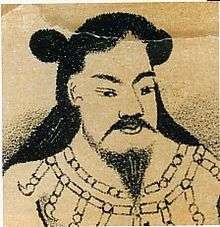Emperor Itoku
| Itoku | |
|---|---|
 | |
| Emperor of Japan | |
| Reign | 510 BC – 477 BC (traditional)[1] |
| Predecessor | Annei |
| Successor | Kōshō |
| Born | 553 BC |
| Died | 477 BC (aged 76) |
| Burial | Unebi-yama no minami no Manago no tani no e no Misasagi (Kashihara) |
| Spouse | Amonotoyototsu-hime |
| Issue | Emperor Kōshō |
| House | Yamato |
| Father | Emperor Annei |
| Mother | Nunasoko-Nakatsu-hime |
Emperor Itoku (懿徳天皇 Itoku-tennō); also known as Ooyamatohikosukitomo no Mikoto; was the fourth emperor of Japan[2] according to the traditional order of succession.[3]
No firm dates can be assigned to this emperor's life, but he is conventionally considered to have reigned from 510 BC to 476 BC.[4]
Legendary narrative
Modern scholars have come to question the existence of at least the first nine emperors; Itoku's descendant, Emperor Sujin is the first that many agree might have actually existed.[5] The name Itoku-tennō was assigned to him posthumously by later generations.[6]
Itoku is regarded by historians as a "legendary emperor" and there is a paucity of information about him. There is insufficient material available for further verification and study.[7] The reign of Emperor Kinmei (c. 509 – 571 AD), the 29th emperor,[8] is the first for which contemporary historiography is able to assign verifiable dates;[9] However, the conventionally accepted names and dates of the early emperors were not to be confirmed as "traditional" until the reign of Emperor Kanmu (737–806), the 50th sovereign of the Yamato dynasty.[10]
In the Kojiki and Nihon Shoki only his name and genealogy were recorded. He is believed to be the son of Emperor Annei; and his mother is believed to have been Nunasoko-Nakatsu-hime, who was the granddaughter of Kotoshiro-Nushi-no-kami.[11] The Japanese have traditionally accepted this sovereign's historical existence, and an Imperial misasagi or tomb for Itoku is currently maintained; however, no extant contemporary records have been discovered that confirm a view that this historical figure actually reigned. He is considered to have been the third of eight emperors without specific legends associated with them, also known as the "eight undocumented monarchs" (欠史八代 Kesshi-hachidai).[12]
Jien records that Itoku was the second or third son of Emperor Annei,[13] but the surviving documents provide no basis for speculating why the elder brother or brothers were passed over.[14] He is traditionally believed to have ruled from the palace of Migario-no-miya at Karu in what would come to be known as Yamato Province.[13]
His posthumous name literally means "benign virtue". It is undisputed that this identification is Chinese in form and Buddhist in implication, which suggests that the name must have been regularized centuries after the lifetime ascribed to Itoku, possibly during the time in which legends about the origins of the Yamato dynasty were compiled as the chronicles known today as the Kojiki.[12]

The actual site of his grave is not known.[2] This emperor is venerated at a memorial Shinto shrine (misasagi) in Kashihara. The Imperial Household Agency designates this location as Annei's mausoleum. It is formally named Unebi-yama no minami no Manago no tani no e no misasagi.[15]
Consort and children
Empress: Amonotoyototsu-hime (天豊津媛命)
See also
Notes

- ↑ "Genealogy of the Emperors of Japan" at Kunaicho.go.jp; retrieved 2013-8-28.
- 1 2 Imperial Household Agency (Kunaichō): 懿徳天皇 (4); retrieved 2013-8-22.
- ↑ Titsingh, Isaac. (1834). Annales des empereurs du japon, p. 4; Brown, Delmer M. (1979). Gushankō, p. 251; Varley, H. Paul. (1980). Jinnō Shōtōki, p. 89.
- ↑ Ponsonby-Fane, Richard. (1959). The Imperial House of Japan, pp. 29–30.
- ↑ Yoshida, Reiji. "Life in the Cloudy Imperial Fishbowl," Japan Times. March 27, 2007; retrieved 2013-8-22.
- ↑ Brinkley, Frank. (1915). A History of the Japanese People from the Earliest Times to the end of the Meiji Era, p. 21, p. 21, at Google Books; excerpt, "Posthumous names for the earthly Mikados were invented in the reign of Emperor Kanmu (782–805), i.e., after the date of the compilation of the Records and the Chronicles.
- ↑ Kelly, Charles F. "Kofun Culture," Japanese Archaeology. April 27, 2009.
- ↑ Titsingh, pp. 34–36; Brown, pp. 261–262; Varley, pp. 123–124.
- ↑ Hoye, Timothy. (1999). Japanese Politics: Fixed and Floating Worlds, p. 78; excerpt, "According to legend, the first Japanese emperor was Jimmu. Along with the next 13 emperors, Jimmu is not considered an actual, historical figure. Historically verifiable Emperors of Japan date from the early sixth century with Kinmei.
- ↑ Aston, William. (1896). Nihongi, pp. 109.
- ↑ Varley, p. 89.
- 1 2 Aston, pp. 142–143.
- 1 2 Brown, p. 251.
- ↑ Ponsonby-Fane, p. 29; Varley, p. 89.
- ↑ Ponsonby-Fane, p. 418.
References
- Aston, William George. (1896). Nihongi: Chronicles of Japan from the Earliest Times to A.D. 697. London: Kegan Paul, Trench, Trubner. OCLC 448337491
- Brown, Delmer M. and Ichirō Ishida, eds. (1979). Gukanshō: The Future and the Past. Berkeley: University of California Press. ISBN 978-0-520-03460-0; OCLC 251325323
- Chamberlain, Basil Hall. (1920). The Kojiki. Read before the Asiatic Society of Japan on April 12, May 10, and June 21, 1882; reprinted, May, 1919. OCLC 1882339
- Nussbaum, Louis-Frédéric and Käthe Roth. (2005). Japan encyclopedia. Cambridge: Harvard University Press. ISBN 978-0-674-01753-5; OCLC 58053128
- Ponsonby-Fane, Richard. (1959). The Imperial House of Japan. Kyoto: Ponsonby Memorial Society. OCLC 194887
- Titsingh, Isaac. (1834). Annales des empereurs du Japon (Nihon Ōdai Ichiran). Paris: Royal Asiatic Society, Oriental Translation Fund of Great Britain and Ireland. OCLC 5850691
- Varley, H. Paul. (1980). Jinnō Shōtōki: A Chronicle of Gods and Sovereigns. New York: Columbia University Press. ISBN 978-0-231-04940-5; OCLC 59145842
| Regnal titles | ||
|---|---|---|
| Preceded by Emperor Annei |
Legendary Emperor of Japan 510 BC – 477 BC (traditional dates) |
Succeeded by Emperor Kōshō |